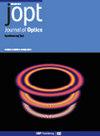石墨烯-手性-石墨烯多层中光学天幕的多维动态控制
IF 2.7
4区 物理与天体物理
Q3 OPTICS
引用次数: 0
摘要
光学天幕是一种具有复杂矢量场结构的拓扑准粒子。它们具有超小、超快和拓扑保护等相关特性,在高密度数据存储、光物质相互作用和光通信等领域具有广阔的应用前景。目前,光学天幕的研究仍处于起步阶段,不同拓扑纹理的构建和灵活调控是当前的研究热点。在此,我们将材料的扭曲自由度与光学天幕结合起来。基于石墨烯-手性-石墨烯多层结构,我们证明了场模对称和杂化形成的布洛赫型石墨烯质子天元晶格。同时,通过改变手性参数、石墨烯的费米能和入射光的相位,可以实现布洛赫型光学天离子的多维控制。我们的工作表明,材料的特性为调节拓扑状态提供了额外的维度,而不同材料结构的组合为动态构建和操纵多种拓扑状态提供了可能,有望在集成纳米光子器件中找到应用。本文章由计算机程序翻译,如有差异,请以英文原文为准。
Multidimensional dynamic control of optical skyrmions in graphene–chiral–graphene multilayers
Optical skyrmions are topological quasiparticles with a complex vectorial field structure. Their associated characteristics of ultra-small, ultra-fast and topological protection have great application prospects in high density data storage, light matter interaction and optical communication. At present, the research of optical skyrmions is still in its infancy, where the construction and flexible regulation of different topological textures are current research hotspot. Here, we combine the twist degree of freedom of materials and optical skyrmions. Based on graphene–chiral–graphene multilayers structure, we demonstrate the field mode symmetry and hybridization to form Bloch-type graphene plasmons skyrmion lattice. At the same time, by changing chirality parameter, the Fermi energy of graphene and the phase of incident light, multidimensional control of Bloch-type optical skyrmions can be realized. Our work demonstrated that the properties of materials provide the additional dimensions to regulate the topological states, and the combination of different materials structures provides the possibility for dynamic construction and manipulation of multiple topological states, which is expected to find applications in integrated nanophotonics devices.
求助全文
通过发布文献求助,成功后即可免费获取论文全文。
去求助
来源期刊

Journal of Optics
OPTICS-
CiteScore
4.50
自引率
4.80%
发文量
237
审稿时长
1.9 months
期刊介绍:
Journal of Optics publishes new experimental and theoretical research across all areas of pure and applied optics, both modern and classical. Research areas are categorised as:
Nanophotonics and plasmonics
Metamaterials and structured photonic materials
Quantum photonics
Biophotonics
Light-matter interactions
Nonlinear and ultrafast optics
Propagation, diffraction and scattering
Optical communication
Integrated optics
Photovoltaics and energy harvesting
We discourage incremental advances, purely numerical simulations without any validation, or research without a strong optics advance, e.g. computer algorithms applied to optical and imaging processes, equipment designs or material fabrication.
 求助内容:
求助内容: 应助结果提醒方式:
应助结果提醒方式:


